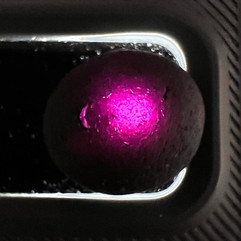One of my favourite finds on the beach, and luckily one that is plentiful, is pirate glass.
A lot of pirate glass pieces are wonderfully thick, rounded and full of bubbles. This tells us they are lovely old pieces. Beers and spirits were stored in these dark coloured vessels from the 1700s to the 1870s. By darkening the glass the contents were protected from sunlight, and the glass was thick so the bottles could be reused.
Boats would carry these for months at sea, holding rum rather than water so it wouldn't contaminate and it's probably safe to assume that these were targeted by 'pirates.'
When you shine a light through pirate glass, the true colour beneath is revealed. Glass from the 1700s was usually olive green, and later made with amber coloured glass. There are however other colours to be found too. More unusual colourings include reds, purples, blues and yellows.
Old lightbulb insulators give themselves away with their 'button' shapes, and under a torch they shine a wonderful reddish purple. They were used in the early 1900s. Another colour, black amethyst, was used to make decorative items and if you find one of these, the deep purple once revealed elicits a gasp.
The different colours you find are created using different metals in the glass. Holland produced blue gin bottles and Portugal red bottles.
Pirate glass with shades of blue seem something of an enigma. It could be old ink well or the bulbous shape of onion bottles from the 1700s. It's creation is caused by the 'wrong' mix of ingredients whilst making the glass which creates 'glass gall.' It looks magical in the right light, and if you find a piece that is covered, it's like looking into space.
A complete onion bottle went up for auction last year and the guide price was £800-£1200 but it sold for £11,000! Hands up, which one of you sea glass addicts nabbed it?!
You can also find slag and galaxy glass - a wonderful blue shade, and a byproduct of the metal smelting process. But that is a whole other post!
Bubbles are usually present in the pieces that predate the 1800s so you know you have an oldie if you find one of these. Have you found any?
How To Find Pirate (or any) Sea Glass
So you want to find some black sea glass? Well there's a reason I find so much. People don't realise they're walking over it when they're hunting the beach for the more obvious colours. But there are things that can help you spot it.
1) Unnatural shapes - perfect circles, beans and dents. All things that might suggest what could pass as a pebble actually isn't.
2) Texture - If it looks too smooth to be a pebble, it might just be. It will also have lovely little 'c' marks within the glass from years of tumbling amongst the waves.
3) Colour - it's usually one solid colour, and it can often glow more than it should. If you see a pebble like this, pop it on your phone torch just to check. You never know!

I find so many pieces of pirate glass on the beaches of Dorset and Devon and often daydream about where they came from and what their story has been.
Suffice to say I have many drawers full!
My favourite I hear you ask? It's hard to pick, but I have a VERY soft spot for this piece I found on a holiday - cork still intact!
As for jewellery, I find the jet black of sea glass a wonderful shade for using with faux suede, or in chunkier necklaces. They also look fabulous in jewellery for men, and perfect circles look fabulous in cufflinks.























Comments